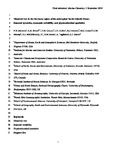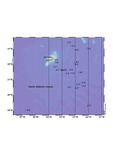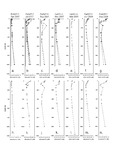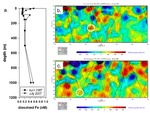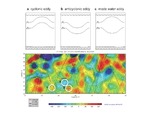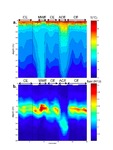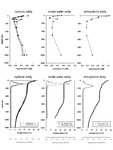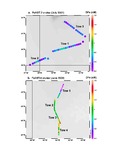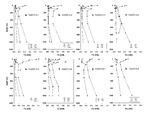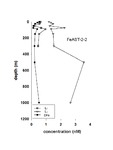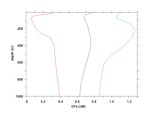Dissolved iron in the Bermuda region of the subtropical North Atlantic Ocean: Seasonal dynamics, mesoscale variability, and physicochemical speciation
| dc.contributor.author | Sedwick, PN | |
| dc.contributor.author | Bowie, AR | |
| dc.contributor.author | Church, TM | |
| dc.contributor.author | Cullen, JT | |
| dc.contributor.author | Johnson, RJ | |
| dc.contributor.author | Lohan, MC | |
| dc.contributor.author | Marsay, CM | |
| dc.contributor.author | McGillicuddy, DJ | |
| dc.contributor.author | Sohst, BM | |
| dc.contributor.author | Tagliabue, A | |
| dc.contributor.author | Ussher, Simon | |
| dc.date.accessioned | 2020-02-06T10:58:40Z | |
| dc.date.available | 2020-02-06T10:58:40Z | |
| dc.date.issued | 2020-02-20 | |
| dc.identifier.issn | 0304-4203 | |
| dc.identifier.issn | 1872-7581 | |
| dc.identifier.other | 103748 | |
| dc.identifier.uri | http://hdl.handle.net/10026.1/15361 | |
| dc.description | 18 months embargo minus one day to account for leap year. | |
| dc.description.abstract |
Water-column data from seven cruises in 2007–2008 reveal pronounced temporal and spatial variations in the distribution of dissolved iron (DFe, <0.4 μm) over the upper 1000 m of the Sargasso Sea near Bermuda, in the western subtropical North Atlantic Ocean. In near-surface waters, DFe exhibits a clear seasonal cycle, increasing from ~0.1–0.3 nM in spring to ~0.4–1.0 nM in summer-early fall. The observed seasonal ranges appear to reflect the extent of winter convective mixing and of summer dust deposition, both of which are closely tied to atmospheric circulation processes. Surface DFe concentrations also show significant (~two-fold) submesoscale lateral variations during summer, perhaps as a result of lateral inhomogeneities in wet deposition and wind-driven mixing. The summer vertical profiles reveal pronounced DFe minima and sometimes deeper maxima in the lower euphotic zone, which likely reflect biological uptake and shallow remineralization, and eddy-driven lateral gradients in these processes. Significant variability is also seen in the mesopelagic zone, with a DFe concentration range of ~0.4–0.7 nM at 1000 m depth, which may reflect mesoscale isopycnal displacements and/or lateral advection of iron-rich waters in the lower thermocline. Physicochemical iron speciation measurements indicate that the major fraction of DFe that accumulates in surface waters of the Sargasso Sea during summer is colloidal-sized Fe(III), which appears to be complexed by strong, iron-binding organic ligands. Concentrations of soluble iron (sFe, <0.02 μm) were considerably lower than DFe in the upper euphotic zone during summer, except over the subsurface DFe minima, where sFe accounts for ~50–100% of the DFe pool. Labile Fe(II), on average, accounted for around 20% of DFe, with maximum concentrations of around 0.1 nM in near-surface waters and in the lower thermocline. The seasonal-scale DFe changes that we have documented near Bermuda are of the same magnitude as basin-scale lateral gradients across the North Atlantic, underscoring the importance of time-series observations in understanding the behavior of trace elements in the upper ocean. | |
| dc.format.extent | 103748-103748 | |
| dc.language | en | |
| dc.language.iso | en | |
| dc.publisher | Elsevier BV | |
| dc.subject | Dissolved iron | |
| dc.subject | Seasonal variability | |
| dc.subject | Physicochemical speciation | |
| dc.subject | Sargasso Sea | |
| dc.title | Dissolved iron in the Bermuda region of the subtropical North Atlantic Ocean: Seasonal dynamics, mesoscale variability, and physicochemical speciation | |
| dc.type | journal-article | |
| dc.type | Journal Article | |
| plymouth.author-url | https://www.webofscience.com/api/gateway?GWVersion=2&SrcApp=PARTNER_APP&SrcAuth=LinksAMR&KeyUT=WOS:000513991800002&DestLinkType=FullRecord&DestApp=ALL_WOS&UsrCustomerID=11bb513d99f797142bcfeffcc58ea008 | |
| plymouth.volume | 219 | |
| plymouth.publication-status | Published | |
| plymouth.journal | Marine Chemistry | |
| dc.identifier.doi | 10.1016/j.marchem.2019.103748 | |
| plymouth.organisational-group | /Plymouth | |
| plymouth.organisational-group | /Plymouth/Faculty of Science and Engineering | |
| plymouth.organisational-group | /Plymouth/Faculty of Science and Engineering/School of Geography, Earth and Environmental Sciences | |
| plymouth.organisational-group | /Plymouth/REF 2021 Researchers by UoA | |
| plymouth.organisational-group | /Plymouth/REF 2021 Researchers by UoA/UoA07 Earth Systems and Environmental Sciences | |
| plymouth.organisational-group | /Plymouth/Research Groups | |
| plymouth.organisational-group | /Plymouth/Research Groups/BEACh | |
| plymouth.organisational-group | /Plymouth/Research Groups/Marine Institute | |
| plymouth.organisational-group | /Plymouth/Users by role | |
| plymouth.organisational-group | /Plymouth/Users by role/Academics | |
| plymouth.organisational-group | /Plymouth/Users by role/Researchers in ResearchFish submission | |
| dcterms.dateAccepted | 2019-11-14 | |
| dc.rights.embargodate | 2021-7-2 | |
| dc.identifier.eissn | 1872-7581 | |
| dc.rights.embargoperiod | Not known | |
| rioxxterms.funder | Natural Environment Research Council | |
| rioxxterms.identifier.project | Carbon Uptake and Seasonal Traits in Antarctic Remineralisation Depth (CUSTARD) | |
| rioxxterms.versionofrecord | 10.1016/j.marchem.2019.103748 | |
| rioxxterms.licenseref.uri | http://www.rioxx.net/licenses/all-rights-reserved | |
| rioxxterms.licenseref.startdate | 2020-02-20 | |
| rioxxterms.type | Journal Article/Review | |
| plymouth.funder | Carbon Uptake and Seasonal Traits in Antarctic Remineralisation Depth (CUSTARD)::Natural Environment Research Council | |
| plymouth.funder | Carbon Uptake and Seasonal Traits in Antarctic Remineralisation Depth (CUSTARD)::Natural Environment Research Council |


